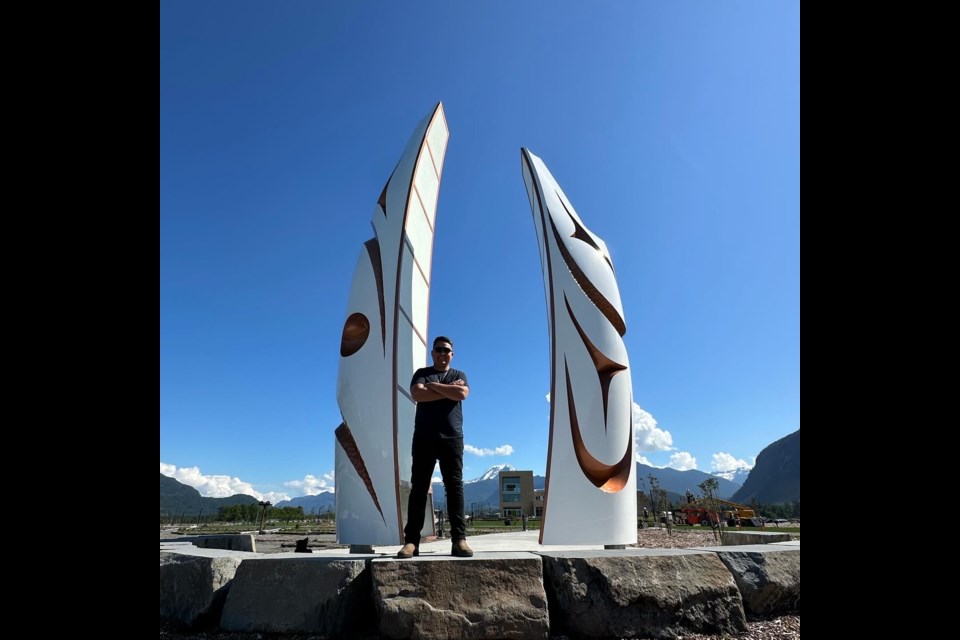A striking sight 24 hours a day, James Harry's fibreglass, stainless steel, copper and LED-lit public art piece at the ocean's edge in Sp’akw’us Feather Park draws attention from locals and visitors alike.
Many stop to pose in front of the more than 12-metre (40-foot) piece or gaze up in wonder.
Commissioned by Oceanfront Squamish developer Matthews West, the piece was in the works for four years, before being installed earlier this month.
Harry knows Squamish well, having been raised coming up from the Lower Mainland to visit family, including grandmother, Sḵwx̱wú7mesh Úxwumixw (Squamish Nation) Elder Chésha7 Gwen Harry.
His father is renowned artist Xwalacktun Rick Harry, who attended school in Squamish, and now resides in West Vancouver, as does his son.
"I've always just been inspired and in awe of the surrounding landscape, especially with the [Stawamus] Chief and the ocean," Harry said. "It has always had a spiritual energy to it. One of the things that I was thinking about, especially once I was asked to do the project, was what does Squamish represent to me? And, if I was thinking wider, what does it mean to the Squamish people? And what does it represent to Canadians and people living there?"
The piece evolved from his efforts to imagine what would have historically been out on waterfronts when Sḵwx̱wú7mesh people would carve welcoming figures, to welcome those coming to shore.
"I was also thinking of how important the canoe is for our people. The waters were our highways, and this would have been the first thing you see coming into Squamish," said Harry, who aims with his work to deconstruct Coast Salish art and reimagine it in new ways.
"If you could imagine one paddling up or boating into Howe Sound and you see Nch'ḵay̓ [Mount Garibaldi] at the back. We have a really old story that's like 10,000 years old of how our people were flooded out during the great flood," he said, referencing the Sḵwx̱wú7mesh tale of ancestors attaching themselves to the mountain’s peak to ride out the rising flood waters.
Nch'ḵay̓ is visible through the Welcome Gate's pillars.
In addition, the piece symbolizes the interconnection between the supernatural and the natural world.
"That was the thinking with the lighting [of the piece] at night—symbolically, the light represents that spirit."
The piece pays homage to history and tradition, while putting a modern spin on it.
"I came up with [the name] Welcome Gate because I didn't want to quite say a welcome figure, but I wanted to say that it's like a welcoming or like a portal or entry into Squamish," he said.
Future generations
Harry's daughter with his partner and fellow artist Lauren Brevner, Hana, is two years old; she was born halfway through the creation of the Welcome Gate piece.
(She enjoys playing on the new oceanfront playground, Harry said.)
"It's really incredible that all of this is happening in the early stages of her life, because she's seeing all these pieces growing up," he said, referencing other recent works, such as his sculpture unveiled a few weeks ago in New Westminster, outside of təməsew̓txʷ Aquatic and Community Centre.
"She's growing up with it as a part of her identity. And to me, that's what's really important, is that we feel seen and heard," he said.
"Especially with what is traditional versus contemporary. And how we're always adapting and changing. That's what art does—it's always challenging us to think in new ways. And I'm just really happy that she gets to be a part of that from such an early stage in life."
Harry added that Hana will grow into a life where she feels "super proud" of her identity, something he said he struggled with as a kid growing up in New Westminster, often the lone Indigenous student of his classmates.
Process
To create Welcome Gate, Harry started by crafting miniature versions of each pillar out of yellow cedar.
They were 3D-scanned and entered into computer software, which is the same software that architects use.
He worked with fabrication companies to make his vision a giant reality.
The final piece was put on a flatbed truck and brought in from a fabricator in Alberta.
Harry noted a lot of engineering went into the finishing process, explaining that a lot of concrete had to be poured for the artwork's base and the pillars had to have a way for someone to get inside to change the lights.
What is next?
There will be a blessing ceremony for the Welcome Gate in July.
Harry also has other projects on the go, including a large sculpture outside the Lions Gate Hospital in North Vancouver later this summer.
He has also been dedicating time to the Indigenous Design Charter, a document for governments and corporations of how best to work with Indigenous artists.
"It's basically a living document that I want more people to be aware of," he said.
He said that Matthews West took it upon themselves to be Indigenous-led in their project's design, but that isn't always the case with other organizations and governments.
"When we're thinking of architecture or design, and the design of our cities and the identity of our cities that we're thinking about Indigenous-led because we're here from this land, where we're trying to reclaim space and show more of our identity," he said, adding that Canada could learn from other countries, such as Australia and its charter.
To find out more about Harry and his art, go to his website or Instagram page.




